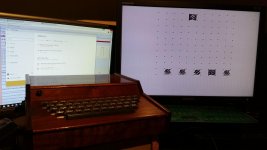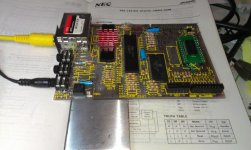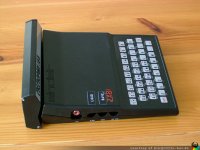falter
Veteran Member
A tape recorder made for a computer (TRS-80) was always likely to be mono, but I thought I'd better ask.
If you use a headphone output either in 'Headphone' or 'Line Out' mode to drive a microphone input directly you have a serious mismatch in levels - the MIC input on a recorder is expecting just a few millivolts from a real microphone, so the ZX81 outputs a similar, tiny signal from its MIC connector. The output from the PC is huge by comparison.
Since the recorder has a 'Line In' socket (sometimes called AUX IN) then using that input (rather than the microphone input) in conjunction with the PC with its output mode set to 'Line Out' would be the correct way to go.
If the recorder didn't have a 'Line In / Aux In' input then you could try making this little level reducer circuit (see image - I kept it small so the forum wouldn't reject it - click on it to see a hopefully more readable version). This will reduce the 'big' output from the PC to the much smaller level expected by the microphone input on the recorder.
Note the use of a stereo plug at the PC end and a mono plug at the ZX81 end. Plugging a mono plug into the stereo output of a PC will short one of its outputs directly to ground, which is undesirable and may upset the audio amplifier or eventually even damage the output in question.
View attachment 30051
The resistor values chosen are pretty arbitrary, the preset (variable resistor) will need to be set quite close to the 'low' end (but not all the way off!) for best results.
For your own setup I would try the PC in Line Output mode and connect it to the Aux In, not Microphone in, of your recorder. I would still make up a lead with a stereo plug at the PC end, for the reason stated above, but it won't need the level reducer resistors.
Thanks guys. I'll try that. But one thing I'm wondering.. I have seen literally half a dozen videos of people loading programs on their zx81s/ts1000s via mp3 player or phone.. how are they able to pull that off?



